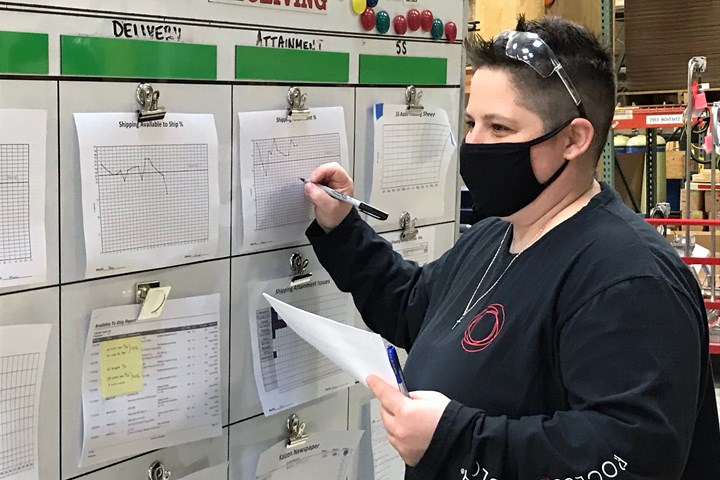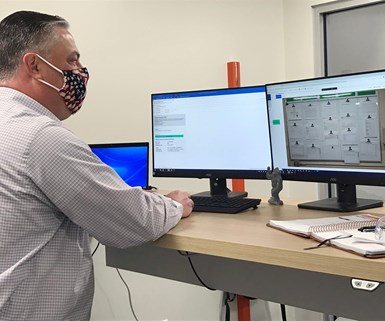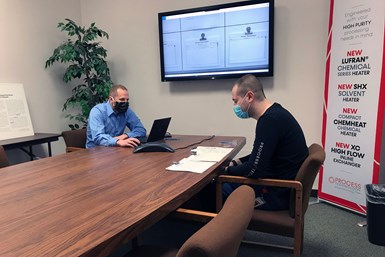
Prior to the coronavirus pandemic, Process Technology was employing the lean practices of gemba walks and would typically have 12-15 people reviewing boards on the shop floor. The company found itself needing a new way to facilitate open communication. Source | Process Technology
If you work in any area of manufacturing, then you’re likely familiar with lean manufacturing principles aimed at the elimination of waste and continuous improvement of your production process. In this unprecedented time, when the COVID-19 pandemic has created unique challenges that most involved in the manufacturing industries have never experienced, it can be easy to allow the principles of lean to take a back seat. In actuality, however, organizations can benefit from practicing lean now more than ever.
Process Technology (Willoughby, Ohio), supplier of heating and power solutions, found itself dealing with the problem of communication during social distancing. With face-to-face meetings canceled in favor of virtual meetings, the company was concerned about fully understanding what was happening on the shop floor.
Featured Content
Before the coronavirus pandemic, Process Technology was employing the lean practices of gemba walks — routine visits to the shop floor to identify wastefulness and opportunities for improvement.

Bob Dragolic, director of operations, reviews a job board from the safety of his office. Source | Process Technology
Bob Dragolic, director of operations, explains, “Early on, the Governor issued the stay at home order, so not everybody was showing up. Plus, we weren't supposed to gather in groups of more than 10. Our gemba was typically 12 to 15 people who would be wandering throughout the floor.”
Gemba is a Japanese word meaning “the actual place,” yet gathering en masse on the shop floor was no longer a possibility. The company found the restrictions put in place to combat the coronavirus unraveling the lean principles it was working so hard to promote within the facility.
So the challenge then became how to conduct the gemba walks within the confines of social distancing. At first, the team members at Process Technology tried walking the floor and observing the boards individually, but it wasn’t the same. By the end of the second week, the boards weren’t being updated. Simply walking the floor and comparing notes was not proving as effective — and after a few weeks, it ceased happening at all.
“I think it fell to the wayside because there wasn’t a preplanned time,” says Dragolic. “There's always some something in your face that’s demanding your attention. So, without the gemba, things were not getting done.”

A video conference meeting is employed for each department to presents information from its board to the gemba team. Source | Process Technology
Hoping to recapture the success the company was experiencing with its gemba walks prior to the pandemic, Dragolic worked with Process Technology’s continuous improvement manager, Jared Lawrence, to find a solution. Together, they initiated a video conferencing process that Process Technology now refers to as the “virtual gemba.” Each morning, Lawrence captures images of gemba boards throughout the plant. Later, during a video conference meeting, each department presents information from its board to the gemba team for review and discussion. The company says the process allows for real-time conversations with people working from home about issues within the plant.
“We continue to listen to our people and their ideas. People working from home feel more connected to the plant they normally work in; it reinforces a sense of team and unity,” Bob Dragolic says. “Virtual gemba is one new practice we will implement going forward in all our remote facilities to enable larger participation.”
Lessons for the future
The innovation doesn’t stop with the gemba. As Process Technology looks ahead, it plans to use lessons learned from its virtual gemba to help train other locations on lean manufacturing principles, conduct process audits and create opportunities for remote customer visits.
“We’re trying to roll lean out to our Amery, Wisconsin plant. One of my fears was that I wasn’t going to be on-site enough,” says Dragolic. “But I now believe that with the virtual gemba, I can be with them every day during their lean rollout.”
Sid Srivastava, senior vice president of strategy for Process Technology, takes it a step farther. “You can bring the same standards of quality, the same centers of excellence, which you all have developed in one site, and you can transfer it remotely to another.”
“With working from home becoming more normal, participating in a virtual gemba and being part of a manufacturing facility that is hundreds and thousands of miles away, and being part of that day-to-day run there … the way you manage becomes completely different, because you are in touch with what is really going on, in real time there,” he adds. “We intend to take this forward, absolutely.”
Dragolic reflects on the past few months, “I think one of the things that I took away from this is just how vital face-to-face communication is — seeing each other face-to-face, and reading the body language.”
To use a popular COVID-era mantra, “We’re all in this together.” As the whole of manufacturing navigates the ever-changing landscape of the pandemic, an increasing amount of work is being done remotely and the trend will only continue. Yet, the separation imposed by the pandemic is emphasizing how important some manner of face-to-face contact is — even if it has to be done via video conference.




















